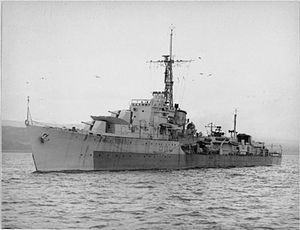HMS Zebra (R81)

| |
| History | |
|---|---|
| Name | HMS Zebra |
| Namesake | zebra |
| Ordered | 12 February 1942 |
| Builder | William Denny & Brothers, Dumbarton |
| Laid down | 14 May 1942 |
| Launched | 18 March 1944 |
| Commissioned | 13 October 1944 |
| Identification | Pennant number: R81 |
| Fate | Arrived in Newport for breaking up 12 February 1959 |
| General characteristics | |
| Class and type | Z-class destroyer |
| Displacement | 1,710 tons |
| Length | 362 ft 9 in (110.57 m) |
| Beam | 35 ft 8 in (10.87 m) |
| Draught | 10 ft (3.0 m) |
| Propulsion | Twin steam turbines |
| Speed | 37 knots (69 km/h; 43 mph) maximum |
| Complement | 185 |
| Armament |
|
HMS Zebra was a
Design and construction
The Z-class were War Emergency Programme destroyers, intended for general duties, including use as anti-submarine escort, and were to be suitable for mass-production. They were based on the hull and machinery of the pre-war J-class destroyers, but with a lighter armament (effectively whatever armament was available) in order to speed production.[1][2] The Z-class of eight ships formed the 10th Emergency Flotilla, one of five flotillas of War Emergency destroyers ordered under the 1941 War Construction Programme (the U, V, W, Z and Ca-classes (40 destroyers)).[3]
The Z-class were 362 feet 9 inches (110.57 m)
The ship had a main gun armament of four
The eight destroyers of the Z-class were ordered in February 1942,[a] The ship that was to become Zebra was laid down at William Denny and Brothers's Dumbarton shipyard on 14 May 1942 as Wakeful.[10][13] The ship was renamed in January 1943,[14] with the destroyer that was previously to be named Zebra, under construction at Fairfield's was renamed Wakeful at the same time.[15] Zebra was launched on 8 March 1944 and completed on 13 October 1944,[10][13] commissioning the same day.[16] She was the sixth ship called Zebra to serve with the Royal Navy.[17]
Second World War
After commissioning, Zebra underwent a period of working up before joining the
Postwar
After the end of the war Zebra joined the 4th Destroyer Flotilla in which she served until 1947. The vessel was then paid-off and was reduced to reserve status in the Plymouth Reserve Fleet. During 1952 she was with the Harwich Reserve Fleet and returned to Plymouth a year later.[23]
Decommissioning and disposal
The ship was nominated for conversion to an anti-submarine frigate and her main armament was to be removed. However, in 1955 this work was cancelled and the ship was placed on the Sale List. There were plans to transfer her to West Germany, but after inspection by West German officials the proposal was rejected due to her poor condition and she was sold to BISCO in 1958 for breaking-up at Newport, Monmouth by Cashmore. On 12 February 1959 she arrived in tow at the breakers yard.
Notes
References
- ^ Friedman 2008, pp. 53–55, 86–87
- ^ Whitley 2000, pp. 124–127
- ^ Friedman 2008, pp. 90–91, 328
- ^ Whitley 2000, p. 135
- ^ a b c d e f Lenton 1970, p. 37
- ^ Gardiner & Chesneau 1980, p. 43
- ^ Friedman 2008, pp. 92–93
- ^ Marriott 1989, p. 52
- ^ a b Raven & Roberts 1978, p. 48
- ^ a b c Friedman 2008, p. 328
- ^ English 2008, p. 108
- ^ Raven & Roberts 1978, p. 3
- ^ a b English 2008, p. 207
- ^ a b c English 2008, p. 110
- ^ English 2008, pp. 100, 207
- ^ Colledge & Warlow 2006, pp. 395–396
- ^ Ruegg & Hague 1993, pp. 70–71
- ^ a b Rohwer & Hümmelchen 1992, p. 322
- ^ Ruegg & Hague 1993, p. 72
- ^ Ruegg & Hague 1993, p. 73
- ^ Ruegg & Hague 1993, p. 74
- ^ Critchley 1982, p. 84
Bibliography
- ISBN 978-1-86176-281-8.
- Critchley, Mike (1982). British Warships Since 1945: Part 3: Destroyers. Liskeard, UK: Maritime Books. ISBN 0-9506323-9-2.
- English, John (2008). Obdurate to Daring: British Fleet Destroyers 1941–45. Windsor, UK: World Ship Society. ISBN 978-0-9560769-0-8.
- ISBN 978-1-84832-015-4.
- Gardiner, Robert; Chesneau, Roger, eds. (1980). Conway's All The World's Fighting Ships 1922–1946. London: Conway Maritime Press. ISBN 0-85177-146-7.
- Marriott, Leo (1989). Royal Navy Destroyers Since 1945. Ian Allan Ltd. ISBN 0-7110-1817-0.
- Lenton, H. T. (1970). Navies of the Second World War: British Fleet & Escort Destroyers Volume Two. London: Macdonald & Co. ISBN 0-356-03122-5.
- Raven, Alan; Roberts, John (1978). War Built Destroyers O to Z Classes. London: Bivouac Books. ISBN 0-85680-010-4.
- Rohwer, Jürgen; Hümmelchen, Gerhard (1992). Chronology of the War at Sea 1939–1945. London: Greenhill Books. ISBN 1-85367-117-7.
- Ruegg, Bob; Hague, Arnold (1993). Convoys to Russia 1941–1945. Kendal, UK: World Ship Society. ISBN 0-905617-66-5.
- Whitley, M. J. (1988). Destroyers of World War 2. Annapolis, Maryland: Naval Institute Press. ISBN 0-87021-326-1.
- Whitley, M. J. (2000). Destroyers of World War 2: An International Encyclopedia. London: Cassell & Co. ISBN 1-85409-521-8.
